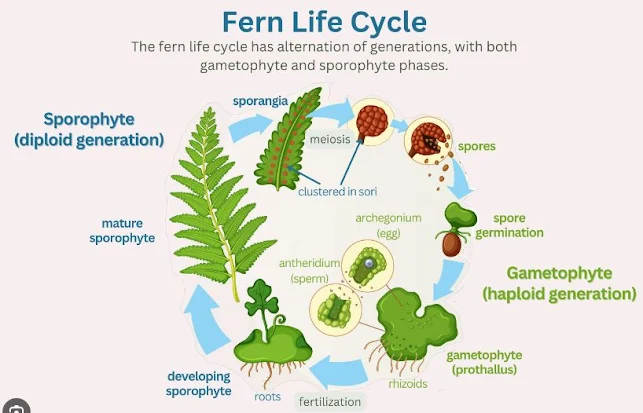Alternation of Generations
Difference Between Gametophyte and Sporophyte:
The life cycle of the fern has two different stages; sporophyte, which releases spores, and gametophyte, which releases gametes. Gametophyte plants are haploid, sporophyte plants diploid. This type of life cycle is called the alternation of generations.
Gametophyte is a stage in the life cycle that is found in all plants and certain species of algae.
Ex. Mosses.
A sporophyte is a diploid spore-forming plant that emerges as a result of the fusion of haploid gametes.
Ex. Fern.
Gametophyte:
Process: Mitosis
Production of gametes
Chromosome number haploid
a single set of chromosomes
sexual reproduction
Gametes fuse to form diploid zygote (2n)
Sporophyte:
1. Process: Meiosis
2. Formation of spores
3. Chromosome number Diploid(2n)
4. single set of chromosomes
5.Asexual reproduction
6. Diploid spore mother cell undergoes meiosis
Fern Life-Cycle
The Fern life cycle has an alternation of generations, with both gametophyte and sporophyte phases.
Higher Plants:
Higher plants have developed several adaptations for life on land - structures and biochemical methods for conserving water that is necessary for all of the biochemical activities of the cell and thus for the maintenance of life. Chief among these adaptations was the evolution of sex organs that are protected by a surrounding layer of non-reproductive cells. Antheridia are male sex organs where sperm cells are produced.
Egg cells are contained in organs called archegonia. Gametes enclosed in these organs are protected against drying out. Another adaptation for the prevention in cell walls provides waterproofing to epidermal tissue and prevents evaporation of water. The higher plants also have special vascular or water-carrying tissues designed to distribute water efficiently throughout the plant body.
Bryophyta:
The bryophytes are the first green land plants. They are primitive, small, and inconspicuous. Although multicellular, the tissue differentiation is quite simple. Bryophyte species have no tissues that are specialized for water-carrying and no cambium specialized for growing new cells. Bryophyte species do not have true stems, leaves, or roots. Simple root-like structures called rhizoids anchor the plants to the ground and absorb moisture from the soil.
Alternation of generations occurs in all bryophytes. The larger and more noticeable generation is the gametophyte, which usually supports a smaller (sometimes parasitic) sporophyte. Ciliated sperm cells, produced in the antheridia, swim to the archegonia and fertilize the egg cells held therein. The sporophyte generation begins with the zygote and is therefore diploid. Special cells in the sporophyte go through meiosis and produce haploid spores that begin the gametophyte generation.
There are 23,000 species of bryophytes among which are the mosses, the liverworts, and the hornworts, a group of plants structurally similar to the liverworts.
Tracheophyta- Vascular Plants:
The vascular plants are truly land-dwelling plants. They have developed adaptations that permit them to live on land independent of bodies of water. The word vascular means that these plants have a water-carrying system. Water is conducted upward from the roots by xylem tubules. Fluid compounds are conducted downward from the leaves to lower plant organs by the phloem tubules.
The tracheophytes are divided into five subdivisions: psilopsids, club mosses, horsetails, ferns, and seed plants.
Psilopsida:
There is disagreement among botanists as the whether there are two living genera- Psilotum and Tmesiperteris - of psilopsids or whether all members of this subdivision are extinct. The plants that may represent the psilopsids have rather simple bodies, with branched stems, but no roots. The leaves are absent or very small.
Lycopsida - Club Mosses:
There are about 900 living species of club mosses. Plants in this group are usually one meter or less in height. Many are ground creepers. The club mosses have water-carrying (vascular) tissues and true roots, stems, and leaves. The leaves are small and spirally arranged on the stems. The popular name of the Lycopsida is derived from the arrangement of the sporangia which are clustered on leaves formed into cones or strobili. Some club moss species bear one type of spore and one type of gametophyte: such species are described as being homosporous. Other species of club moss are heterosporous because they bear two types of spores and produce two types of gametophytes.


